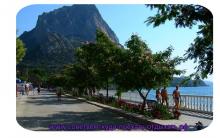Trans-Baikal Territory is an administrative-territorial unit of the Russian Federation. The territory of the region is located in the Asian part of the country, regions of Eastern Siberia. The southern regions share a common border with Mongolia and China. The Territory occupies a vast territory of Transbaikalia and has an administrative division into 30 districts. The territory is dominated by a medium-sized relief with small areas of hilly relief and plains.
Satellite map Trans-Baikal Territory represents photo Transbaikal Territory from the satellite in high resolution. Use + and - in the left corner of the map to enlarge the satellite image of the Trans-Baikal Territory.
Zabaykalsky Krai. Satellite view
Satellite map of the Trans-Baikal Territory can be viewed in both a sketch map and satellite view by switching views on the right side of the map.
The region's river network has more than 40,000 watercourses. Large rivers Shilka, Argun. The Ivano-Arakhlei system of lakes is located not far from Chita. Three large rivers of Asia begin at once from the slopes of Mount Palassa, which is part of the Apple Ridge: Yenisei, Lena, Amur. Large cities: Chita, Krasnokamsk, Borzya.
Chita. Satellite map online
(The map is controlled with the mouse, as well as the signs in the right corner of the map)
The climate of Transbaikalia is sharply continental. Winter is harsh with persistent frosts, followed by warm, sometimes hot summers. There is little precipitation, most of it falls in the summer.
Most of the edge is located in the taiga zone. Areas of low mountains and plains have steppe vegetation, the lower part of the mountain slopes is covered with forest-steppe areas, above which there are zones of mountain taiga.
Such a variety natural areas makes flora and fauna unique. Birch, deciduous, coniferous forests are replaced by mountain taiga with thickets of Daurian larch and Siberian cedar. Above, there are areas of dwarf cedar, lichen tundra. Among the animals there is an abundance of valuable fur-bearing animals: sable, Siberian weasel, ermine, lynx. Abundance of large mammals: bear, deer, red deer, badger, wolf. There are many valuable fish species in the rivers: omul, sturgeon, taimen, whitefish.
In Transbaikalia there is a unique Daursky nature reserve, the Dalkhanay national park, the Tsasucheysky bor nature reserve, and the Sokhondinsky nature reserve. Healing springs of mineral and thermal waters were discovered in the region.
The main attractions of Transbaikalia include the Church of the Assumption of the Mother of God in the village of Kalinino, Kazan Cathedral, Daursky Reserve, Alkhanai, Charsky Sands, Butinsky Palace, Lake Arey, Kodara glaciers, Great source and Aginsky datsan.
Maps of the cities of the Trans-Baikal Territory: Chita | Baley | Borzya | Krasnokamensk | Mogocha | Nerchinsk | Petrovsk-Zabaikalsky | Sretensk | Khilok | Shilka
Transbaikal Territory on the map of Russia
The Trans-Baikal Territory is located on the territory of Eastern Siberia of Russia. It stretches from south to north for many thousands of kilometers. Its most extreme point is the Baikal-Amur Mainline. Plains, high mountains, all this refers to the relief of Transbaikalia.
The climate in the Trans-Baikal Territory is continental and sharp. Atmospheric precipitation is rare. Cold in winter and cool in summer.
Scientists claim that life in this ecologically clean place originated approximately long before modern days. It was about 35 - 150 thousand years ago. On the surface, archaeologists recently found the first traces of human presence near the Khilok River. According to the latest census data, more than one million people now live in the region.
Look at show detailed map The Trans-Baikal Territory with settlements is marked by territorial and administrative division. These are more than 800 settlements in rural areas, 42 urban-type settlements and quite a few cities.
The sights are the marble gorge. A mineral spring flows in this small valley. The house - museum of the wives of the Decembrists is located in the city of Zabaikalsky - Petrovsky. In it now you can see portals with bas-reliefs, monuments - crosses, sculptural compositions and so on. The map of the Trans-Baikal Territory is able to tell a lot of interesting things.
Satellite map of the Trans-Baikal Territory. Explore the satellite map of the Trans-Baikal Territory online in real time. A detailed map of the Trans-Baikal Territory was created on the basis of high-resolution satellite images. As close as possible, the satellite map of the Trans-Baikal Territory allows you to study in detail the streets, individual houses and attractions of the Trans-Baikal Territory. The map of the Trans-Baikal Territory from the satellite easily switches to mode regular card (diagram).
Zabaykalsky Krai, which is often called simply Transbaikalia, is a region of Russia located in Siberia and bordering several countries at once - Mongolia and China. The administrative center of the region is the city.
The climatic conditions in Transbaikalia are quite severe, which is explained by the location of the Transbaikal Territory in the continental climatic zone. Average winter temperatures reach -28 ... -29 C. Summer in the region is warm, but short. The average July temperature is + 18 ... + 19 C.
Main attractions Transbaikalia are natural. On the territory of this region of Russia there are two large reserves - Sokhondinsky and Daursky reserves. The Daursky Reserve was founded relatively recently, in 1987, but already has international significance. Its territory belongs not only to Russia, but also to Mongolia and China. On the territory of this protected area, you can see more than 40 species of mammals, several hundred species of birds and more than 500 insects. There are also several large lakes in the Daursky Reserve. Sokhondinsky Reserve is somewhat older and larger in territory. It was founded in 1973 and is located in the Chita region.
Tourists are attracted to the Trans-Baikal Territory not only by natural objects and their beauty, but also by great opportunities for both active and relaxing rest. The main tourist routes in Transbaikalia are walking and water routes. Fans of ecological tourism prefer to spend their free time in the bosom of nature in reserves and national parks. Those who wish to relax with benefit, at the same time improving their health, go to health resorts. Fortunately, there are a great many of them in Transbaikalia, because to date more than 300 mineral springs have been discovered in the region.
The most famous resorts of the Trans-Baikal Territory are Darasun, Molokovka, Shivanda and Yamarovka.
Satellite map of Zabaikalsky Krai
Satellite map of the Trans-Baikal Territory. You can view a satellite map of the Trans-Baikal Territory in the following modes: a map of the Trans-Baikal Territory with the names of objects, a satellite map of the Trans-Baikal Territory, a geographical map of the Trans-Baikal Territory.Zabaykalsky Krai , which is often called simply Transbaikalia, is a region of Russia located in Siberia and bordering several countries at once - Mongolia and China. The administrative center of the region is the city of Chita.
The climatic conditions in Transbaikalia are quite severe, which is explained by the location of the Transbaikal Territory in the continental climatic zone. Average winter temperatures reach -28 ... -29 C. Summer in the region is warm, but short. The average July temperature is + 18 ... + 19 C.
Main attractions Transbaikalia are natural. On the territory of this region of Russia there are two large reserves - Sokhondinsky and Daursky reserves. Daursky Reserve was founded relatively recently, in 1987, but already has international significance. Its territory belongs not only to Russia, but also to Mongolia and China. On the territory of this protected area, you can see more than 40 species of mammals, several hundred species of birds and more than 500 insects. There are also several large lakes in the Daursky Reserve. Sokhondinsky Reserve is somewhat older and larger in territory. It was founded in 1973 and is located in the Chita region. www.site
Tourists are attracted to the Trans-Baikal Territory not only by natural objects and their beauty, but also by great opportunities for both active and relaxing rest. The main tourist routes in Transbaikalia are walking and water routes. Fans of ecological tourism prefer to spend their free time in the bosom of nature in reserves and national parks. Those who wish to relax with benefit, at the same time improving their health, go to health resorts. Fortunately, there are a great many of them in Transbaikalia, because to date more than 300 mineral springs have been discovered in the region.
Zabaikalsky Krai is a region in Eastern Siberia located in the east of Transbaikalia. The satellite map of the Trans-Baikal Territory shows that the region borders on Mongolia, China, Buryatia, Yakutia, Irkutsk and Amur regions. Territory area - 431 892 sq. km.
The Trans-Baikal Territory is divided into 31 districts. There are 10 cities, 41 urban-type settlements and 750 settlements in the region. The largest cities in the region are Chita (center), Krasnokamensk, Borzya, Petrovsk-Zabaikalsky, Aginskoye and Nerchinsk.
The economy of the Trans-Baikal Territory is based on the extraction of minerals, metallurgy, animal husbandry, the food industry and mechanical engineering. The region has large reserves of coal, iron ore, timber and tin.
Charsky Sands, Trans-Baikal Territory
Brief history of the Trans-Baikal Territory
The Trans-Baikal Territory was formed as a result of the unification of the Aginsky Buryat Autonomous District and the Chita Region in 2008. Today it is the youngest constituent entity of the Russian Federation.
The development of Transbaikalia by the Russians began in the 17th century. In the 19th century, the Trans-Baikal Region was formed, which at the beginning of the 20th century became part of the Irkutsk Governor-General. During the Great Patriotic War, the Trans-Baikal Front was formed in this region.

Velikiy Istok (Mount Pallas, Trans-Baikal Territory), from where the water flows into three great rivers - Lena, Amur and Yenisei
Attractions of the Trans-Baikal Territory
On a detailed map of the Trans-Baikal Territory, you can see numerous natural attractions: the Alkhanai National Park, the Daursky Reserve, Beklemishevskie Lakes and the Ivano-Arakhlei system of lakes.
It is recommended to visit the following attractions in the Trans-Baikal Territory: Shivanda mineral springs, the Charskie Sands tract with moving loose sands, Mount Alkhanay (a place of pilgrimage for Buddhists), the Baisanids Lamsky town, located at an altitude of 2000 m above sea level and the Kondui Mongol town of the XIV century ... It is also worth visiting the largest cities in the region and seeing their sights.











Naruto storm 4 sees gamepad
Now on the map: how the new Yandex
Radar Data Maps Radar Observation Map
Where is Mexico - detailed map of the world with cities in Russian Geographic map of Mexico
Organization of game processes in a multiplayer game Entering another level in a computer game